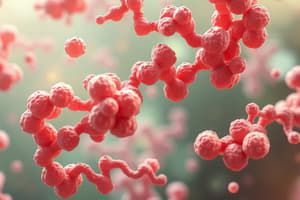Podcast
Questions and Answers
What is the main function of proteins secreted to the bacterial cell surface?
What is the main function of proteins secreted to the bacterial cell surface?
Which system do Gram-negative bacteria often use to inject proteins into host cells?
Which system do Gram-negative bacteria often use to inject proteins into host cells?
Which process involves bacteria adapting to environmental changes using a phosphate transfer mechanism?
Which process involves bacteria adapting to environmental changes using a phosphate transfer mechanism?
What is an example of a beneficial infection in the human body?
What is an example of a beneficial infection in the human body?
Signup and view all the answers
How do opportunistic infections typically arise?
How do opportunistic infections typically arise?
Signup and view all the answers
What is the primary outcome of a response regulator binding to DNA in bacterial signaling?
What is the primary outcome of a response regulator binding to DNA in bacterial signaling?
Signup and view all the answers
What role does Type 1 secretion system play in Gram-negative bacteria?
What role does Type 1 secretion system play in Gram-negative bacteria?
Signup and view all the answers
What is a common product of bacteria involved in external secretion?
What is a common product of bacteria involved in external secretion?
Signup and view all the answers
What role do beneficial infections play in the host's health?
What role do beneficial infections play in the host's health?
Signup and view all the answers
How do viruses typically enter a host cell?
How do viruses typically enter a host cell?
Signup and view all the answers
What is the function of the HIV Tat protein in relation to viral infection?
What is the function of the HIV Tat protein in relation to viral infection?
Signup and view all the answers
What example demonstrates the relationship between marine microbes and their environment?
What example demonstrates the relationship between marine microbes and their environment?
Signup and view all the answers
What process is involved in the formation of biofilms?
What process is involved in the formation of biofilms?
Signup and view all the answers
How do gut microbes contribute to the human body?
How do gut microbes contribute to the human body?
Signup and view all the answers
What is the mechanism of action for Enteropathogenic E.coli (EPEC) during infection?
What is the mechanism of action for Enteropathogenic E.coli (EPEC) during infection?
Signup and view all the answers
What is the consequence of dysbiosis in the microbiome?
What is the consequence of dysbiosis in the microbiome?
Signup and view all the answers
Study Notes
Protein Secretion Mechanisms in Bacteria
- Surface secretion anchors proteins to the bacterial cell structure (e.g., peptidoglycan) for interactions like adhesion or immune evasion. Gram-positive bacteria often use the sortase system with specific motifs (e.g., LPXTG).
- External secretion releases proteins outside the bacteria to interact with or disrupt the environment or host. Gram-negative bacteria, for example, use Type 1 secretion systems via ABC transporters, while Type 3 secretion systems function like a syringe injecting proteins into host cells. Exotoxins are common products and damage host cells.
Bacterial Two-Component Signal Transduction Systems (TCSs)
- Bacteria use TCSs to sense and respond to stimuli in their environment.
- A stimulus activates a histidine kinase in the membrane.
- The histidine kinase autophosphorylates itself.
- The phosphate is transferred to a response regulator in the cytoplasm, activating a response.
- Response regulators bind to DNA to regulate gene expression. This enables bacteria to adapt to environmental changes, including quorum sensing in biofilms.
Types of Microbial Infections
- Beneficial: Microbes contribute positively to the host, often as part of the normal microbiome (e.g., gut microbes compete with pathogens for resources).
- Opportunistic: Normally harmless microbes cause harm if the host's defenses are weakened (e.g., Pseudomonas aeruginosa in immunocompromised individuals).
- Pathogenic: Microbes inherently cause disease in healthy hosts (e.g., Vibrio cholerae producing toxins that damage the intestines).
Viral Infection Mechanisms
- Viruses attach to host receptors (e.g., HIV and CD4 co-receptors). They enter the cell via endocytosis or membrane fusion.
- Viruses use host machinery to replicate their genomes (e.g., HIV reverse transcribing RNA into DNA).
- Viruses manipulate host systems to create suitable environments (e.g., HIV using Tat and Rev proteins to enhance viral processes).
Microbial Interactions with the Environment
- Marine microbes: Symbiotic relationships exist (e.g., bioluminescent bacteria with squid). Viruses play a role in nutrient recycling.
- Biofilms: Quorum sensing and interspecies communication are involved in formation; biofilms influence nutrient cycles and can cause biofouling in aquatic environments.
Microbial Interactions with the Human Host
- Normal flora: Beneficial microbes (e.g., Lactobacillus in the vagina maintaining low pH) create a hostile environment for pathogens or produce essential nutrients.
- Pathogenic interactions: Some bacteria (e.g., EPEC using Type 3 secretion systems and Tir protein) manipulate host cells for attachment and disease.
- Dysbiosis: Disturbances in the microbiome (e.g., antibiotic use and C. difficile overgrowth) can cause harmful consequences.
Studying That Suits You
Use AI to generate personalized quizzes and flashcards to suit your learning preferences.
Description
Explore the mechanisms of protein secretion in bacteria and the role of two-component signal transduction systems. This quiz covers specific systems used by Gram-positive and Gram-negative bacteria, as well as the processes involved in sensing environmental stimuli. Test your knowledge on how bacteria interact with their environment and host cells.




